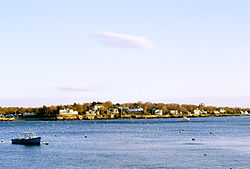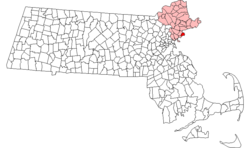Marblehead, Massachusetts
Marblehead, Massachusetts | |
|---|---|
 Marblehead Neck as viewed from the Landing on State Street. | |
 Location in Massachusetts | |
| Country | United States |
| State | Massachusetts |
| County | Essex County |
| Settled | 1629 |
| Incorporated | 1649 |
| Government | |
| • Type | Open town meeting |
| Elevation | 65 ft (20 m) |
| Population (2000) | |
| • Total | 20,377 |
| Time zone | UTC-5 (Eastern) |
| • Summer (DST) | UTC-4 (Eastern) |
| ZIP code | 01945 |
| Area code | 339 / 781 |
| Website | http://www.marblehead.org |
| Town Website | |
Marblehead is a town in Essex County, Massachusetts, United States. As of the 2000 census, the town population was 20,377. It is home to the Marblehead Neck Wildlife Sanctuary. A yachting resort, Marblehead includes the unincorporated community of Clifton.
History
Marblehead was first settled as a plantation of Salem in 1629 by John Peach Sr, then set off and incorporated in 1649. Originally called Massebequash after the river which ran between it and Salem, the land was inhabited by the Naumkeag Indians under the sachem, Nanepashemet. But epidemics in 1615-1619 and 1633, believed to be smallpox, devastated the tribe. Heirs of Nanepashemet would sell their 3,700 acres on September 16, 1684, the deed preserved today at the town hall.
At times called Marvell Head, Marble Harbour (by Captain John Smith) and Foy (by immigrants from Fowey, Cornwall), the town would be named Marblehead by settlers who mistook its granite ledges for marble Founder John Peach Sr. It began as a fishing village with narrow, crooked streets, and grew inland from the harbor. The shoreline smelled of drying fish, typically cod, which were exported abroad and to Salem. The town peaked economically just prior to the Revolution, as locally financed privateering vessels pirated the seas for bounty from large European ships. Much early architecture survives from the era, including the Jeremiah Lee Mansion.
A large percentage of residents became involved early in the fight for American freedom, and the sailors of Marblehead, under General John Glover, are generally recognized by scholars as forerunners of the American Navy. The first vessel commissioned for the navy, the Hannah, was equipped with cannons, rope, provision (including the indigenous "Joe Frogger" molasses/sea water cookie) -- and a crew from Marblehead. Many who set out for war, however, did not return. Indeed, the community lost a substantial portion of its population and economy. After the conflict, fishing would remain important, with 98 vessels (95 of which exceeded 50 tons) putting to sea in 1837. But a gale or hurricane at the Grand Banks of Newfoundland on September 19, 1846 sank 11 vessels and damaged others. With 65 men and boys lost in the storm, the town's fishing industry began a decline.
During the late 1800s, Marblehead experienced a short-term boom from shoe-making factories. At the same time, the exceptional harbor attracted yachting and yacht clubs. It would become home to the Boston Yacht Club, Corinthian Yacht Club, Eastern Yacht Club, Marblehead Yacht Club, Dolphin Yacht Club, and the oldest junior yacht club in America, the Pleon Yacht Club.
Geography
Marblehead is located at 42°29′49″N 70°51′47″W / 42.49694°N 70.86306°WInvalid arguments have been passed to the {{#coordinates:}} function (42.497146, -70.863236).Template:GR
According to the United States Census Bureau, the town has a total area of 50.8 km² (19.6 mi²). 11.7 km² (4.5 mi²) of it is land and 39.1 km² (15.1 mi²) of it (76.92%) is water. Marblehead is situated on Massachusetts Bay and Salem Bay. The town is comprised of a rocky peninsula that extends into the Atlantic Ocean, with a neck connected by a long sandbar. This ring of land defines Marblehead's deep, sheltered harbor.
Demographics

As of the censusTemplate:GR of 2000, there were 20,377 people, 8,541 households, and 5,679 families residing in the town. The population density was 1,736.8/km² (4,498.9/mi²). There were 8,906 housing units at an average density of 759.1/km² (1,966.3/mi²). The racial makeup of the town was 97.56% White, 0.44% Black or African American, 0.08% Native American, 0.98% Asian, 0.03% Pacific Islander, 0.19% from other races, and 0.73% from two or more races. Only Hispanic or Latino of any race were 0.88% of the population.
There were 8,541 households out of which 31.2% had children under the age of 18 living with them, 56.5% were married couples living together, 8.0% had a female householder with no husband present, and 33.5% were non-families. 28.7% of all households were made up of individuals and 10.7% had someone living alone who was 65 years of age or older. The average household size was 2.37 and the average family size was 2.94.

In the town the population was spread out with 23.9% under the age of 18, 3.5% from 18 to 24, 28.0% from 25 to 44, 29.0% from 45 to 64, and 15.6% who were 65 years of age or older. The median age was 42 years. For every 100 females there were 89.3 males. For every 100 females age 18 and over, there were 84.3 males.
The median income for a household in the town was $73,968, and the median income for a family was $99,892. Males had a median income of $70,470 versus $44,988 for females. The per capita income for the town was $46,738. About 3.2% of families and 4.3% of the population were below the poverty line, including 5.7% of those under age 18 and 4.6% of those age 65 or over.

Points of interest
- Crocker Park, the gift of Uriel Crocker
- Crowninshield Island
- Devereux Beach
- Herreshoff Castle
- Marblehead Neck Wildlife Sanctuary
- The Driftwood
- The Lighthouse
Historical Sites & Museums
- Abbot Hall (1877), containing The Spirit of '76 by Archibald MacNeal Willard
- Fort Sewall (1644)
- Frost Folk Art Museum
- G.A.R. & Civil War Museum
- King Hooper Mansion (1768)
- Jeremiah Lee Mansion (1768)
Notable residents
- Frank Black, contemporary musician
- W. Starling Burgess, yacht designer & aircraft manufacturer
- Uriel Crocker, publisher, businessman
- Elbridge Gerry, politician
- John Glover, Revolutionary War general
- Tyler Hamilton, cyclist
- Ted Hood, yachtsman, America's Cup winner
- Harry Kemelman, novelist
- Peter Lynch, investor, author
- Joseph Story, Supreme Court justice
- Cory Schneider, Vancouver Canucks top-prospect goaltender
- Shalane Flanagan, American-record holding distance runner
Film references
Movies filmed in Marblehead include:
- Autumn Heart (2000)
- Hocus Pocus (1993)
- Moonlight Mile (2002)
- Treading Water (2001)
- The Good Son (1993)
- Coma (1974)
- The Witches of Eastwick
- What's the Worst That Could Happen? (although filmed in Manchester-by-the-Sea, scenes are said to be set in town)
H.P. Lovecraft based his fictional Massachusetts town Kingsport on Marblehead. The real Marblehead, as well as Lovecraft himself, appears in the 1985 Richard A. Lupoff novel Lovecraft's Book. It also features in the eponymous 1978 Marblehead by Joan Thompson.
Author Ben Sherwood set his acclaimed novel The Death and Life of Charlie St. Cloud in Marblehead, featuring the Waterside Cemetery. Harry Kemelman wrote a series of mystery novels around a character, "Rabbi Small", who solves various murder cases in a town very similar to Marblehead, nicknamed "Barnard's Crossing". Kemelman lived in Marblehead for 50 years. Marblehead is referred to as the Birthplace of the American Navy.
Robert B. Parker supposedly based the fictional town of Paradise on Marblehead in his Jesse Stone book series, going so far as to include the annual Race Week yachting event.
Trivia

Excluding those on Cape Cod, Marblehead is one of the easternmost towns in Massachusetts. As such, it receives the first rays of morning sun. This is the origin of the Boston slang phrase, "Light dawns over Marblehead" -- a double entendre signifying the moment when a dullard (marble head) finally comprehends.
References




